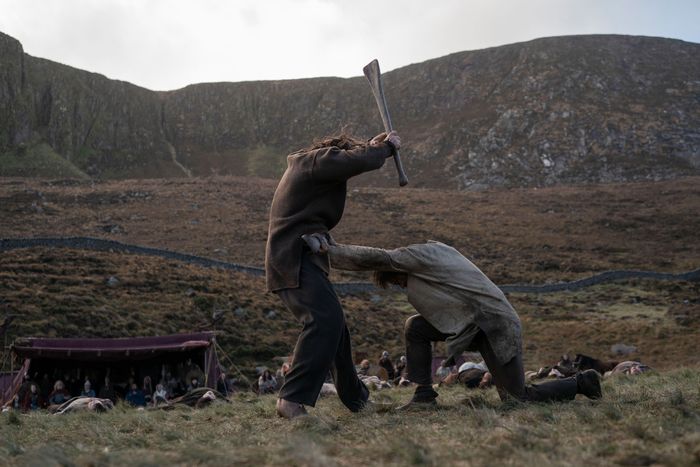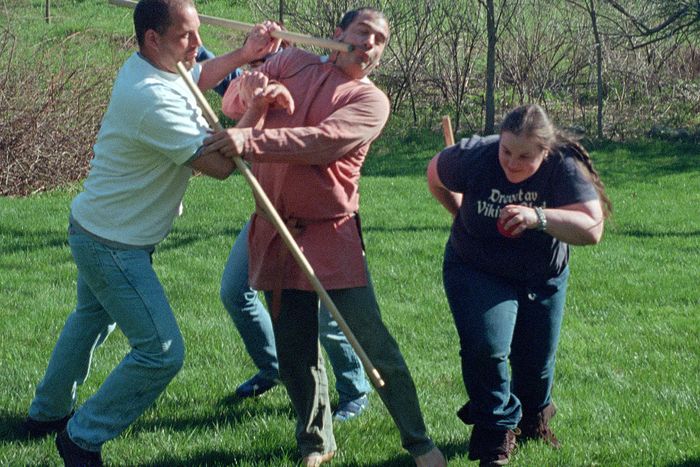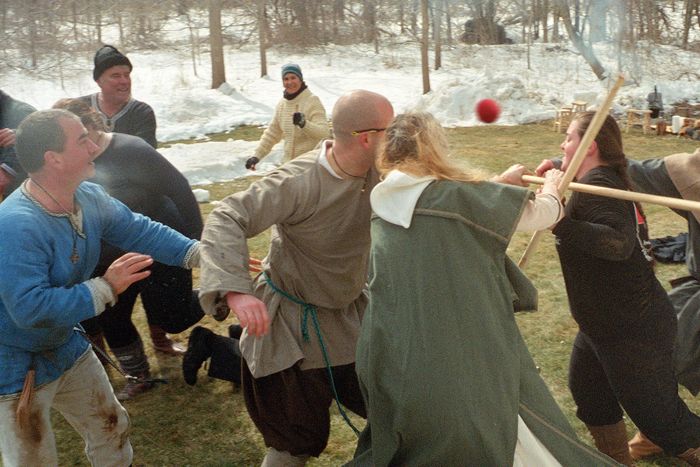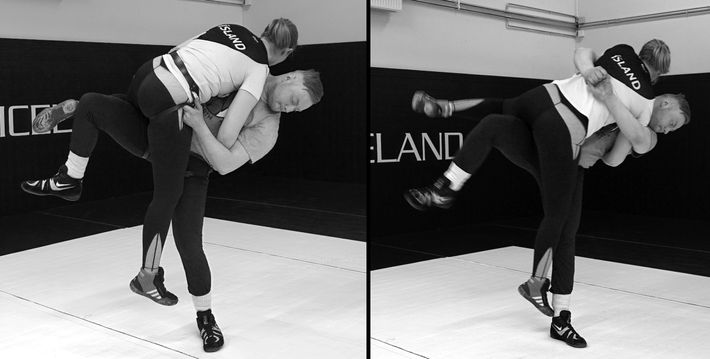
Midway through Robert Eggers’ Viking epic The Northman, crowds begin to gather for the Icelandic frontier equivalent of a medieval tourney. Local chieftains and their families watch from a nearby platform as five of this rugged land’s most brutal men — including our hero, Amleth (Alexander Skarsgård) — line up on either side of a flat green field. Clutching bats in their muscular hands, the players charge forward, roaring like bloodthirsty beasts. Their bodies collide as they tackle, trip, and slam one another into the ground, beating one another unconscious with bats and fists. It’s a free-for-all, and the only rule seems to be to get the ball to the other end of the field by any means necessary.
One by one, men are knocked out and dragged off of the field, until only Amleth and one other player remain. In order to get close to his estranged uncle Fjölnir (Claes Bang), Amleth, who’s posing as a slave, knows he has to do something dramatic. So, in perhaps the most over-the-top of The Northman’s many violent moments, Amleth pins his opponent to the ground and bludgeons him to death with his forehead, slamming his skull into the other man’s face until his rival is a bloody, pulpy mess. Fjölnir’s clan wins, and Amleth is rewarded for his performance in the game.
So how much of that game is based in historical fact? Well, the murder-by-head-butt may not be. But beyond that, it’s not too far off — as far as we know, anyway.
William Short and Reynir A. Óskarson are experts on Viking warfare, which, as they explain to me over Zoom, relied more on grappling and improvised weapons than the stylized, choreographed sword fighting seen in The Northman. Vikings “wanted to show off their beautiful clothing and colorful things, but in a fight it was just Get it done. Let my name be known,” Óskarson says. (One scene that is consistent with the Vikings’ propulsive, no-bullshit fighting style, according to Óskarson, is the berserker raid early on in the film.) The duo wrote a book called Men of Terror that analyzes Viking combat techniques through both a cultural and a functional lens. They put that knowledge into practice as members of the “experimental archaeology” group Hurstwic Viking Combat, which specializes in safely re-creating Viking life at war and at play. Both men have played the Viking game seen in The Northman, albeit (barely) toned down for modern times.
The Icelandic name for the sport is knattleikr — which, literally translated, means “ball game.” The rules of the game, as described in medieval source materials, are just as vague. Knattleikr is mentioned several times in the Icelandic sagas, a collection of stories about the great families of Iceland written by anonymous authors in the 13th and 14th centuries. But the only details that have survived, according to the Hurstwic website, are “that people played the game, that players had disputes, and frequently, that blood was spilled.”
“Some years ago, I was reading the sagas, the literary sources, and I thought, It’d really be cool to figure out how this game was played,” Short says. “I looked in old books and actually went to a lot of the places in Iceland where this game is described as being played, trying to figure out the playing field.” Over several years of trial and error, Short and his colleagues were able to come up with a set of rules — with the caveat that, as Short says, “Vikings did not categorize things much.” There may have been multiple games collectively known as knattleikr, and the rules may have varied over time and in different regions.
Hurstwic’s version of knattleikr is now played once a year at the group’s annual feast in Massachusetts. (It’s also played in Iceland and at a handful of New England colleges.) Contemporary players use hardwood dowels about an inch and a half thick and four feet long as bats and either soft foam balls or hurling balls, depending on the intensity of the match. According to Short, “in the literary sources, it seems like the ball is pretty hard. There’s an example where someone throws the ball and it causes the person who is hit to bleed.”
Using a leather and cork ball is one concession to the 21st century. Another is the protective padding players wear at Hurstwic games. But since the rules of knattleikr were never formally codified in medieval times, it’s up to modern players to decide what’s out of bounds — and it’s still not much. “All the literary sources say is you can throw the ball and you can kick the ball and you can hold on to the ball, but somehow you’ve got to carry the ball over the line to score the point. And other than that, there’s no rules,” Short says.
The game starts when one team throws the ball toward the other, and the opposing team hits it back without letting it touch the ground. From there, game play proceeds like that of any sport where teams compete for possession of a ball: The player with the ball runs toward the opposition’s goal, attempting to score a point. There’s no goalie; just getting the ball over the line will do. The problem is getting there.


Hands, feet, and bats are all fair play in knattleikr, and all can be used either to move the ball down the field or to stop an opponent from scoring. You can slap a ball out of the air, trip another player with your feet or bat, or just knock the other guy to the ground and steal the ball for your team. It’s a rough-and-tumble sport, in other words, with elements of hockey, rugby, football, and lacrosse but fewer rules than any of them. Still, no one has ever been seriously injured at Hurstwic’s knattleikr games — although there was that one time when a ball flew out of bounds, bounced off of a nearby building, and hit a spectator in the head.
One element that’s missing in The Northman’s tournament, and in its combat scenes more generally, is the influence of glíma. “That’s what was painful,” Óskarson says. Glíma is a style of wrestling that has carried over unbroken from Viking settlers to modern Icelanders and was recently submitted to UNESCO as an intangible, essential part of Iceland’s national heritage. In Viking-era Iceland, as Óskarson writes, glíma “was like a Swiss Army knife: one tool with many purposes. Glíma was an activity of entertainment wherever people congregated. Glíma was one of the surest ways to prove oneself and one’s worth to others. Glíma was a practical method for keeping oneself warm during winter travels in the frigid Icelandic climate. Glíma was a brutal weapon and tool of survival in a dangerous world.”
Glíma would have most certainly been an event at a tournament like the one depicted in The Northman, and players would have incorporated its techniques into knattleikr as a way of taking down their opponents. When Hurstwic plays, “there is the element of glíma … we are grappling people, we are throwing them down, ripping the ball from their hands and so on as we play the game,” Short says. Glíma places great emphasis on technique. And while form is presumably less important on the modern knattleikr field, it’s still more controlled than The Northman’s primitive version of the game.
Scattered farm communities from around Iceland would also come together in the warmer months for tournaments that were less formal — and better attended — than the one in The Northman. Iceland in the tenth century was “a pretty flat society” in terms of social strata, Short explains, with more upward mobility and less strict hierarchies than in the rest of Scandinavia. Óskarson adds that the film treats Amleth and his fellow players as “chess pieces for power to play with. We do not get that sense of games in the Viking age.”
Indeed, entire settlements would gather for some good-natured brawling during knattleikr tournaments. Short says that games “included everyone from the district, so that could easily be hundreds of people” on the field at once, all running and tackling one another to the ground. Tournaments would go on for weeks, with temporary housing erected to accommodate players who faced off on the knattleikr field all day — and, based on what we know about Viking culture, they likely drank and perfected the art of the insult at night.
Obviously, the head-bashing outcome of The Northman’s knattleikr game would be extreme even by Viking standards and has more to do with advancing Amleth’s mission of vengeance (and thereby the plot) than historical accuracy. Still, Short and Óskarson say that violence was a constant in Viking culture, as it is in the film. “There’s a reason we called our book Men of Terror rather than something more mundane,” Óskarson says.
Both emphasize the importance of understanding Viking values in order to understand their culture. Orðstír, which literally translates to “word glory,” was extremely important in Viking culture. In fact, it was more important than life itself. By Viking logic, living a long, prosperous life was pointless if you didn’t build a reputation in the process. What you wanted was to impress people with your bravery and skill — usually in battle but maybe in knattleikr, too — so that they would continue to talk about you long after you were gone. “Life is not endless. But if you get a good one, orðstír is endless,” Óskarson explains.
As they go into detail about the gridiron glory of millennia past, it makes sense that both men would be drawn to Viking history. They seem to appreciate bold action, even when the results aren’t what they hoped for. More than that, they share a dry sense of humor that blurs the line between serious threats and good-natured teasing — a very Viking-esque quality. When Óskarson soberly proclaims that Icelanders “will eventually forgive” Robert Eggers for leaving glíma out of The Northman, he seems serious. But there’s a twinkle in his eye that makes you wonder how intense his grudge really is.
The good cheer with which knattleikr enthusiasts approach the violent sport is best illustrated when Óskarson chimes in to add that someone did get a black eye during one of Hurstwic’s knattleikr games. “William clearly forgot about that,” he says with a chuckle. “Oh, yeah, I did forget about that,” Short replies, waving away the concern. “That’s not a serious injury.”


